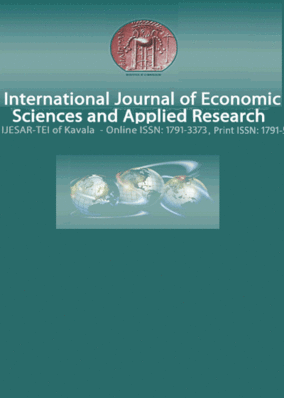Positive and negative impact of increased tertiary attainment
Part of : International journal of economic sciences and applied research ; Vol.6, No.1, 2013, pages 41-57
Issue:
Pages:
41-57
Author:
Abstract:
The theory of human capital clearly states that the investments into the education bring many benefits and are worth the cost. The OECD Education at a Glance analysis provides support for both public and private investing in tertiary education as the net present value is positive for all observed countries. Considering the benefits of education, a growth in tertiary education should be viewed very positively. In this context, the European Strategy Europe 2020 set up one of its main goals for EU27 countries as follows: to increase the educated population so that it reaches 40% (tertiary educated people aged 30-34). This article, on an example of Slovakia, provides an analysis of both positive and negative impact of increased tertiary attainment.
Subject (LC):
Keywords:
higher education, Slovakia, Europe 2020
Notes:
Περιέχει διαγράμματα, πίνακες και βιβλιογραφία
References (1):
- Academic Ranking and Rating Agency (ARRA), 2011, http://arra.sk, (accessed 15/7/2010).Athanassiadis, A., ‘Economic Returns and Risks to Investment in Education: An Applicationof the Multifactor CAPM’, International Journal of Economic Sciences and AppliedResearch, 4, 1, pp. 95-120.Becker, G., 1964, Human Capital: A Theoretical and Empirical Analysis, with SpecialReference to Education, Chicago, University of Chicago Press, ISBN 978-0-226-04120-9.Belovicsovâ, D., 2010, ‘Efektivnosf vÿdavkov na vysokoskolské vzdelanie z pohl’adu ichnâvratnosti’, Ekonomické Spektrum, Rocm'k 5, c. 2/3, 2010.Caplânovâ, A., 2007, ‘Vysokoskolské vzdelâvanie vs. znalostnâ ekonomika’, Νονέ trendy-nové nàpady 2007, New trends - new ideas, 2007, s. 12-13.Caplânovâ, A., 1999, Ekonómia vzdeldvania a tvorba I’udskych zdrojov, Iura Edition, 1999,132 pages, ISBN: 80-88715-22-9.Education at a glance, OECD indicators 2010, www.oecd.org/edu/eag2010, (accessed20112012).Europe 2020, http://ec.europa.eu/europe2020, (accessed 28/7/2009).Faridi, M., Malik, S., Rao, I., 2010, ‘Impact of education and health on employmnet inPakistan: a case study’, European Journal of Economics, Finance and AdministrativeSciences, 18, http://www.eurojoumals.com http://www.eurojoumals.com/ejefas_18_05 .pdf, (accessed 11/5/2011).Folloni, G., Vittadini, G., 2010, ‘Human Capital Measurement: A survey Journal ofEconomic Surveys’, 24, 2, pp. 248-279, http://www.statistica.unimib.it/utenti/vittadini/PUBBLICAZIONI/PUBBLICAZION/Folloni%20Vittadinihuman%20capital.pdf,(accessed 11/5/2011).Haidar, K.., Mallik, G., Does Human Capital Cause Economic Growth? A Case Study ofIndia, International Journal of Economic Sciences and Applied Research, 3, 1, pp. 7-25.Institute of Financial Policy (IFP), 2011, http://finance.gov.sk, (accessed 9/1/2011).Institute of Information and Prognoses of Education in Bratislava, 2011, http://www.uips .sk, (accessed 9/1/2011).Klas, A., 2011, ‘Role of Domestic Technological Development in Innovations’, EkonomicReview, 40, pp. 448-459.Kurekovâ, L., 2010, Eudsky kapitâl: Skolstvo a vzdelâvanie, ceu.academia.edu/luciakurekova/papers/302873, (accessed 29/2/2011).Lisÿ, J. et al., 2003, Dejiny ekonomickych teórii, Bratislava: IURA Edition, 2003, 386pages, ISBN 80-89047-60-2.Ministry of Education, Science, Research and Sport of the Slovak Republic, 2011, http://www.minedu.sk, (accessed 29/2/2011).Palascâkovâ, D., 2008, Vÿchodiskâ a hodnotenie vÿskumu v oblasti vysokoskolskéhoprostredia v kontexte kvality l’udskych zdrojov a konkurencieschopnosti, In SOLTES,Vincent (ed.) National and regional economics VII, Kosice: Technicka univerzita,Ekonomicka fakulta, 2008, s. 707-717, ISBN 978-80-553-0084-9.Römer, R, 1986, ‘Increasing returns and long-run growth’, Journal of Political Economy,94, 5.Slovak Spectator, 2012, Youth employment rate in Slovakia, http://spectator.sme.sk/articles/view/48829/ 10/eurostat_youth unemployment rate in slovakia is_5th_highest_ineu.html, (accessed 15/2/2013).Smith, A., 1776, Wealth of Nations, A Digireads Publishing, 1999, 575 pages, ISBN1-4209-3206-3.Statistical database Eurostat, 2010, ec.europa.eu/eurostat, (accessed 2010-2011).Verejnâ politika, 2002, http://www.verejnapolitika.sk/ecosoc/publikacie_nsvp_kapitola2.pdf, (accessed 15/1/2011).Woodhall, M., 2004, ‘Cost and benefits analysis in educational planning’, InternationalInstitute for Educational planning, UNESCO, Paris, 2004, http://unesdoc.unesco.org/images/0013/001390 /139042e.pdf, (accessed 15/12/2011).World Bank, 2002b, Constructing Knowledge Societies: New Challenges for Tertiary.Education, Washington, D.C., World Bank, http://www.mp.gov.rs/resursi/dokumenti/dok220-eng-WB_ConstructingKnowledge Societies.pdf, (accessed 16/9/2010).




